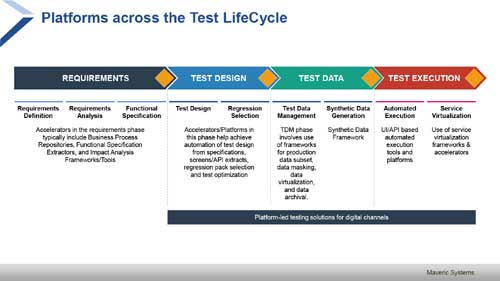As organizations try to improve the quality of their software systems and mobile apps, many of them opt for the solution of buying software testing services from an external provider. This article explains the concept of platform-led software testing and what this solution can bring to improve the results of software quality assurance activities.
Author: Lakshminarasimhan Rajabather, Maveric Systems, http://maveric-systems.com/
With customer demands on the rise every day and expectations of carrying out transactions across various channels gaining popularity, banks all over have embarked on transformation projects aimed at launching newer products in lesser time, increasing their quality, and at the same time reducing costs with every technology/version upgrade.
However, challenges abound in the form of budget overshoots, lack of connectivity between various stages of the software development life cycle (SDLC), lack of value addition, and an overall discrepancy between business goals and IT adoption. Businesses agree that the only solution to this quagmire is a sound software quality assurance strategy, one that helps validate all aspects of an IT adoption right from requirements to release.
Keeping with the trends prevalent in the IT market, quality assurance has also undergone drastic changes. Gone are the days when assurance involved pure manual testing with automation limited to specific processes. Automation is now expected in all stages of the lifecycle in order to increase cost efficiency and productivity. Today, the defining trend, one which has yielded multiple benefits, is that extensive automation is incorporated in all stages of the lifecycle through the development of platform-led assurance solutions.
Platform-led solutions, in this context, refer to assurance services embedded with productivity accelerators that enable an assurance provider to leverage QTE (Quality, Time, and Economy) for clients, increase scope of automation, lower dedicated client staff, etc. These accelerators could be in the form of frameworks, models, assets and methodologies that reduce cost and testing time, while increasing quality and efficiency. While the most basic definition of platform-led solutions might refer to just the automation of test execution, platform-led assurance is also capable of achieving automation of test design from formally specified requirements, functional specifications, API/messaging specifications. They can also help generate metrics that aid in analytic and reporting, thus enabling the assurance provider to offer an End-to-End Quality Proposition.

Figure: Diagram of platforms across the test lifecycle.
Service providers have come to realize that a platform-led approach is the vehicle that enables them to provide their clients with a shift-left approach, maximize the advantages of automation, and hence, they have embraced it without reservations.
Assurance platforms automate test design, test execution, test data management to a large extent and capitalize on high degree of reusability of assets. However, there is so much more that can be leveraged by adopting a platform-led solution model.
- 1. The platform-led approach is in-line with what businesses expect from service providers – QTE (Quality, Time, and Economy) – improved across all stages of the lifecycle: platforms due to their extensive use of automation, reusable scripts and repositories of business cases from previous similar engagements, reduce overall testing time and cost. This enables businesses to implement assurance across all stages of the software development lifecycle.
- When software quality assurance is enabled from the first to last stages of the software development lifecycle thereby providing constant checks and validation, an Integrated Collaborative Assurance value chain emerges where the results or benefits realized in one stage will form the input or can be passed on to subsequent phases.
- With more and more organizations adopting Agile development and Scrum project management, platform-led assurance is the natural solution that promises quick sprints, rapid sign-offs and a measurable transfer of value from one sprint to the next.
- Platforms also offer businesses and service providers the flexibility to build on third-party tools as well industry-standard analytical tools. With little customization, industry-standard tools can be customized to specific institutions’ needs and increase scope of automation while investing minimal effort, time and cost.
- Platforms don’t need to be restricted only to the requirements, design or execution stage of the lifecycle. Project and program management, analytic and reporting can also be included to enable process standardization and efficiencies in test delivery and cost of quality management.
To keep up with changes transforming businesses and IT world over, it is essential that software quality assurance services are robust and capable of properly channeling rapidly changing technological advancements and validating any IT adoption catering to the ever increasing customer expectations. To achieve this end, platform-led assurance has proved itself to be the winning proposition by enabling high levels of automation across all stages of the software development lifecycle and for paving the path for complete automation of assurance itself. In fact, the future of assurance lies in the creation of one all-encompassing platform-led model that will by itself combine various competencies and offer integrated solutions across requirements, test design, execution, analytic, and reporting.
About the Author
Lakshminarasimhan Rajabather is the Vice President, Platform & Technology, of Maveric Systems. He has over 24 years of experience spread across 15 years in Fintech, delivering platforms and systems in Capital Markets, Payments and Investment Banking domains and 7 Years in mission critical and embedded computing.

